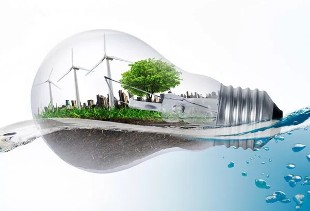Today the situation is so, that man inflicts an environment, causing irreparable damage. In large part this is due to an unjustified use of natural resources. One of the most important tasks of ecology is to preserve and enhance the natural resources.

Ecology and energy savings – these are two concepts that are inextricably linked with one another. Every day we use the electric power for the organization of their life. Thermal power plants, which provide this energy are the most polluting production environment. Of course, if we want to save our planet and live healthy, we need to use this energy sparingly and appropriately. In this way we will be able to reduce the damage caused by the power plant applied nature.
Energy and the environment
The level of development of society is determined by the amount of energy that is consumed in a single person. Today, the main sources of energy are oil, coal and gas. Work and thermal energy boilers and thermal plants different way has an impact on the environment:
- in the atmosphere of our planet enters a large amount of hazardous waste,
- water relieve the harmful substances and heated water,
- consumed a large amount of oxygen,
- large plots of land used under waste polygons and burial.
The pollution of soil, water and air causes the so-called greenhouse effect. By bringing the temperature of our planet increases, and then are activated and other irreversible consequences. It should also be noted that these sources of energy such as oil, gas and coal, is a very difficult language to Italian, and then in a short time because of their irrational use can dry.
Alternative sources of energy
The modern doctrine seek to find alternative sources of energy.
Under the concept of "energy source" refers to natural substances or phenomena that allow people to get energy.
Alternative sources of energy, counter to the traditional sources. To the traditional, as we have already emphasized above, are oil, gas and coal. Alternative sources necessary to minimize the negative impact of traditional sources of energy, which damage the environment. There are sources that can provide alternative energy:
- the energy of the sun
- the energy of the wind
- the energy of the water
- the energy of the earth
- biofuels
The solar energy they receive from solar radiation. Solar energy is considered a renewable energy source. The term "renewable" implies an inexhaustible source of energy. The advantage of this type of energy is its environmental compatibility, that is, the process of obtaining energy does not involve emissions of hazardous waste and does not pollute the environment. The solar energy obtained with the help of solar power plants. This type of energy has both advantages and disadvantages. Among the advantages, the availability and, as mentioned above, the complete safety for the environment.

On the other hand, refers to dependence on weather conditions and the time of day, for which this type of energy, it is possible to use regularly only in certain climatic zones. Disadvantages also apply in the high cost of these power plants, as well as in their production are used for expensive items. Also the exploitation of solar power stations requires the use of large surfaces.
The wind energy produced by the conversion of the kinetic energy of the wind into the atmosphere in any other form of energy. For this they use various devices, for example, wind turbines, wind mills, sails. The energy obtained from the wind, also refer to the renewable types of energy. In addition, the wind energy available and safe for the environment. The advantages of using windy of the energy can be attributed, and that windy power plant, easy to maintain, does not require the installation long and at great expense.
But surely there are some disadvantages, for example, the power of this power plant does not depend on the person, depends on the nature, that is, by the force of the wind. To insignificant against some of the opponents of this technology refer to the danger to the birds, the deterioration of tv reception and radio signals of change in the landscape.
The essence of water energy is to convert the kinetic energy of the water mass into electric energy. The energy is obtained by using a hydroelectric power plant. The force of the water has an impact on the turbines that produce electricity. The advantage of using such systems is that this energy source is inexhaustible. In addition, the hydroelectric energy are safe for the environment. The energy obtained in this way is quite cheap. Together with the advantages there are for and against, for example, the dependence on weather conditions, climatic and natural conditions. Building a station is possible only in certain places. Another disadvantage is that the energy obtained in this way is difficult to maintain for the realization in later times.
In the scientific community of electrical energy, obtained with the help of thermal energy, in the bowels of the Earth, called geothermal energy. Extract its thanks to the use of geothermal power plants. When it cools down the our planet emit massive amounts of energy, which is thousands of times more, highlighting the fossil fuels. The energy of the Earth is a renewable energy source. The advantages of this method of electricity production can be attributed and which is not dependent on environmental conditions. The disadvantages include the high cost of construction and maintenance of such systems. Also consider that such a station can not be defined completely safe for the environment, as a result of a working station of a release of steam, which may contain harmful substances.

Under the concept of biofuels, understood as the fuel that was received from an animal or vegetable raw materials. Biofuels can be of three types:
- solid
- liquid
- gaseous
Solid biofuel is firewood, wood, straw. Today, the man cultivates special, the forests of energy, which are made from the rocks the rapid growth of the trees.
The liquid fuel is represented mainly bioethanol and biodiesel. The bio-ethanol produced mainly from sugar cane and corn. The biodiesel is obtained from vegetable fats and of animal origin.
Gaseous biofuels presented biogas, bio-hydrogen, methane. The biogas obtained from fermentation products of the organic waste. Bio-hydrogen is hydrogen, which has obtained from biomass thermo-chemical or biochemical way.
Conclusion
Today, scientists struggle to reduce the consumption of resources that humanity spends to obtain energy. Every day the required energy more and more, and of resources remains ever less. In the current phase, it is important to learn how to save and rational consumption of energy obtained from traditional sources. Even more important is the development of new, inexhaustible, sources of sustainable energy, this will help you for many years to keep our environment vibrant and healthy.
























